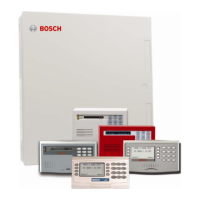D7212GV3 | Operation and Installation Guide | 5.0 Power Supply
.
Bosch Security Systems, Inc. | 10/10 | F01U143079-03 21
5.2.2 Installing the Battery
1. Place the battery upright in the base of the
enclosure.
2. Locate the red and black leads supplied in the
literature pack.
3. Connect the black battery lead to Terminal 4, and
then to the negative (-) side of the battery.
4. Connect the red battery lead to Terminal 5, and
then to the positive (+) side of the battery.
Warning: High current arcs are possible. The
positive (red) battery lead and Terminal 5 can
create high current arcs if shorted to other
terminals or the enclosure. Use caution when
working with the positive lead and Terminal 5.
Always disconnect the positive (red) lead
from the battery before removing it from
Terminal 5.
Caution: The battery terminals and wire are
not power limited. A 6.4 mm (0.250 in.)
space must be maintained between the
battery terminals, battery wiring, and all other
wiring. Battery wiring cannot share the same
conduit, conduit fittings, or conduit knock-
outs with other wiring.
Figure 6: Battery Terminals
1 - Battery terminals. Terminal 5 is non-power
limiting.
5.2.3 Replacing the Battery
Replace batteries every 3 to 5 years under normal
use. Record the date of installation directly on the
battery.
Caution: Exceeding the maximum output
ratings or installing the transformer in an
outlet that is routinely switched off causes
heavy discharges. Routine heavy discharges
can lead to premature battery failure.
D8132 Boost Battery Backup: Adding a D8132
Battery Charger Module supports additional batteries
of up to 27 Ah capacity, if required.
The control panel plus any connected D8132 Modules
and auxiliary power supplies must be on the same AC
circuit to discharge evenly if AC power fails. The
number of D8132 Modules is determined by the
number of available outlets on the same circuit. Refer
to the Standby Battery and Current Rating Chart in
the D7212GV3 Approved Applications Compliance
Guide (P/N: F01U143080) for battery standby time
calculations.
In applications where the supervision of two
batteries is required by the AHJ, use a D113
Battery Supervision Module.
5.2.4 Battery Supervision
When battery voltage drops to 13.8 VDC, the yellow
Charging Status LED lights. When the battery voltage
drops to 12.0 VDC to 11.8 VDC, the red Low Battery
LED lights, and the keypad or keypads display SERVC
LOW BATT. The control panel (if programmed for
power supervision) sends a BATTERY LOW report in
the Modem IIIa
2
communication format. It sends a
Low System Battery (302) report in the Contact ID
format.
If the battery is missing or shorted, the red Low
Battery LED flashes at the same rate as the green
Operation Monitor LED. If the control panel is
programmed for power supervision, it sends a
BATTERY MISSING report in the Modem IIIa
2
communication format, or Control Panel Battery
Missing (311) report in the Contact ID format.
When battery voltage returns to 13.7 VDC, the Low
Battery LED turns off and the keypad or keypads
clear the SERVC LOW BATT message. If the control
panel is programmed for power supervision, it sends
a BATTERY RESTORAL report in the Modem IIIa
2
communication format or a Control Panel Battery
Restored to Normal (302) report in the Contact ID
format. At 13.9 VDC, the yellow Charging Status LED
stops lighting.

